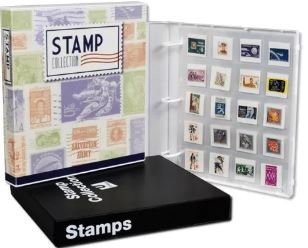Stamp collecting is a fascinating hobby that allows enthusiasts to engage with history, culture, and art through miniature treasures. Whether you are a novice or an experienced collector, the key to maintaining the beauty and value of your stamp collection lies in knowing the right way to store stamps. Proper storage is crucial to protect your collection from physical damage, environmental deterioration, and potential loss in value. In this article, we’ll explore the right way to store stamps and highlight some common mistakes collectors make to help you avoid them.

Why Proper Storage Matters
Stamps are delicate items that can easily be damaged if not stored correctly. Factors such as humidity, temperature, and light exposure can all contribute to the deterioration of your collection. The right way to store stamps ensures that they remain in pristine condition, preserving their value over time. The longer you protect your stamps through proper storage, the more likely they are to stay in excellent condition and retain their worth.
When you understand the right way to store stamps, you prevent damage from creases, bends, fading, discoloration, and even mold. Improper storage can lead to irreversible issues that could diminish the value of your collection or even destroy it entirely.
Step 1: Choose the Right Storage Materials
The first step in the right way to store stamps is selecting high-quality storage materials. Avoid common household materials such as regular paper or cheap plastic bags, as they may contain acids that can damage your stamps over time. Instead, opt for materials that are designed to protect and preserve your collection.
- Stamp Albums: Choose albums that are specifically designed for philatelic collections. Make sure the pages are made of acid-free, archival-quality materials. Albums with glassine or clear plastic sheets allow you to view your stamps while protecting them from environmental factors.
- Stock Pages: Stock pages are plastic sheets with individual pockets that keep stamps safely in place. Ensure the plastic used in these pages is PVC-free and archival-safe to avoid yellowing or deterioration.
- Mounts and Hinges: Mounts are clear, acid-free plastic holders that securely keep your stamps in place without damaging them. Unlike adhesives, which can leave residue or damage gum, mounts are a safe option for the right way to store stamps.
By investing in quality materials designed for philately, you significantly reduce the risk of long-term damage.
Step 2: Control Environmental Conditions
The environment where you store your stamps plays a significant role in their preservation. When considering the right way to store stamps, it is crucial to control factors such as temperature, humidity, and light exposure to minimize the risk of deterioration.
- Temperature: Stamps should be stored in a cool, dry place. Ideally, the temperature should be between 65 and 70°F (18-21°C). Extreme heat or cold can cause stamps to warp, curl, or become brittle. If you store your stamps in an area with fluctuating temperatures, you risk damaging their condition over time.
- Humidity: Stamps are sensitive to moisture, which can lead to mold growth and warping. Ensure that the humidity in your storage area stays between 50-60%. You can use a dehumidifier to prevent excess moisture or a humidifier if the air is too dry.
- Light: Light, especially ultraviolet (UV) rays from the sun, can cause colors to fade over time. To ensure the right way to store stamps, keep your collection out of direct sunlight and limit exposure to artificial light. UV-protective covers or storage containers can help shield your stamps from harmful rays.
By keeping your stamps in a stable environment, you reduce the risk of environmental damage and preserve their condition for the long term.

Step 3: Handle Stamps with Care
Handling stamps properly is an essential aspect of the right way to store stamps. Stamps are fragile, and improper handling can lead to bends, creases, and other types of damage. To keep your collection safe, always handle your stamps carefully.
- Use Stamp Tongs or Tweezers: Never touch the face of a stamp with your bare hands. The oils and dirt from your fingers can leave marks or cause discoloration. Instead, use specialized stamp tongs or tweezers to handle stamps. These tools allow you to grip stamps by the edges, avoiding any contact with the design or perforations.
- Work on a Soft, Clean Surface: When handling stamps, use a clean, soft surface such as a microfiber cloth or a soft mat. This minimizes the risk of scratching or damaging the stamps during handling.
Being mindful of the right way to store stamps involves practicing care when handling them, ensuring their preservation, and avoiding unnecessary wear.
Step 4: Avoid Overcrowding and Overloading Storage Pages
While it may be tempting to fit as many stamps as possible into each page or album, overcrowding is a common mistake that collectors should avoid. When stamps are packed too tightly, they can become damaged from friction, or their perforations can be compromised. To ensure the right way to store stamps, avoid overloading albums or stock pages.
- Give Stamps Room to Breathe: Allow for ample space in between each stamp, ensuring that they are not pressed together too tightly. This minimizes the risk of damage from handling or shifting.
- Use Multiple Pages for Larger Collections: If your collection is growing, consider using multiple pages or albums to keep stamps organized and in good condition.
Allowing your stamps enough space in their storage solutions ensures they are safe from physical damage and maintain their value.
Step 5: Regularly Inspect and Maintain Your Collection
Even after following the right way to store stamps, it is essential to regularly inspect your collection to ensure that it remains in optimal condition. Checking your stamps every few months allows you to catch any issues before they become serious problems.
- Inspect for Moisture or Mold: Periodically check your stamps for any signs of mold or mildew, especially if they are stored in an area with fluctuating humidity. If you find any signs of damage, take immediate steps to address the issue.
- Reorganize as Needed: If stamps shift within their mounts or albums, carefully rearrange them to prevent any accidental bending or creasing.
Regularly maintaining your collection is an important part of the right way to store stamps, helping to identify and address any potential threats to your stamps’ preservation.

In addition to following the right way to store stamps for short-term protection, it’s also crucial to consider long-term storage strategies. Stamps can deteriorate over extended periods if not stored properly. If you’re planning to keep your collection for many years or pass it down to future generations, it’s essential to understand how to store stamps long-term. This involves using specialized containers, controlling environmental factors even more rigorously, and considering long-term preservation techniques. For a deeper dive into ensuring the longevity of your stamps, be sure to check out our article on How to Store Stamps Long Term for expert advice and practical tips.
Conclusion: Protect Your Collection and Avoid Mistakes
In conclusion, the right way to store stamps involves using high-quality materials, controlling the environmental conditions, handling stamps with care, and regularly inspecting your collection. By following these guidelines and avoiding common mistakes, you ensure that your stamp collection will be protected from damage and continue to flourish for years to come.
Remember, proper storage is key to maintaining the value and condition of your stamps. With the right techniques in place, you can enjoy your collection without worrying about wear and tear, knowing that your stamps are safe and preserved for future generations to appreciate



